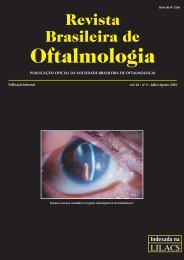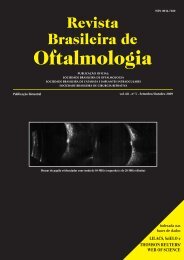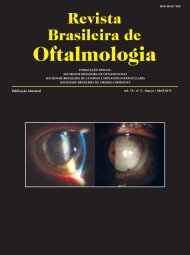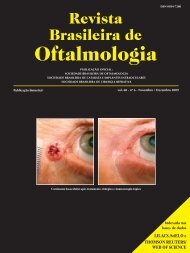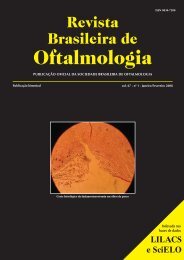Baixe aqui a versão em PDF da RBO - Sociedade Brasileira de ...
Baixe aqui a versão em PDF da RBO - Sociedade Brasileira de ...
Baixe aqui a versão em PDF da RBO - Sociedade Brasileira de ...
- No tags were found...
Create successful ePaper yourself
Turn your PDF publications into a flip-book with our unique Google optimized e-Paper software.
106Caballero JCS, Centurion VDISCUSSIONThe calculation of IOL power <strong>de</strong>pends on the method used,<strong>da</strong>ta on axial length, <strong>da</strong>ta on corneal power and biometric formula(3) .The method used in this study was optical biometry withthe IOL Master - Zeiss ® (5.4 - 5.5) which makes the calculationof axial length by partial coherence interferometry and hasproved more efficient than contact ultrasonic biometry (4) .Corneal power, the focus of major controversy in the eyeswith keratotomy (2) scar, is obtained by the autorefractor biometerin a central area of 2.50mm (different from manual keratometrythat provi<strong>de</strong>s values of an area of 4.00mm (5) ).In addition to our routine corneal power provi<strong>de</strong>d by thebiometer, we obtained an extra keratometry with topographer(Pentacam - Oculus) that in the module Holla<strong>da</strong>y Report allowsus to choose the keratometric value in a central area of 3.0mm (6) .In the latest versions of the IOL Master ® Zeiss (5.4 and 5.5),this double control is not necessary, because the results areextr<strong>em</strong>ely consistent.We completed the propae<strong>de</strong>utics of anterior cornealsurface with topography (Tomey, TMS) that facilitates theinterpretation of the irregularities of corneal surface, in particular,by the presence of irregular astigmatism (7) .We must r<strong>em</strong><strong>em</strong>ber that the keratotomy alters thecurvature of the anterior and posterior central cornea, keepsthe parallelism of the two faces, therefore, it does not alter therefractive in<strong>de</strong>x of the cornea (8) .In relation to biometric formula, our choice is Haigis, whichusing the <strong>da</strong>ta provi<strong>de</strong>d by thebiometer has shown an excellentrefractive predictability (3,6,8) . This predictability is attributed to thefact that Haigis formula “does not <strong>de</strong>pend on” the corneal powerdirectly, but on the anatomic <strong>de</strong>pth of the anterior chamber and itsrelationship to axial length. According to Aramberri, it is the onlyformula that exclu<strong>de</strong>s the Double-Kmethod (9) . IOL constantsshould be up<strong>da</strong>ted monthly on specific sites, thus optimizing IOLdiopter, IOL mo<strong>de</strong>l and the appropriate formula.Our results prove the efficacy of Haigis formula in eyespost keratotomy.We have no doubts in stating that the measur<strong>em</strong>ent of axiallength by optical method is the best option, not only in routinecases as well in challenging cases.Among the last generation formulas, we highlight Haigisthat has been very predictable and reproducible in terms ofrefraction.However, IOL calculation in eyes previously submitted tokeratotomy, is a challenge to obtain a precise and realkeratometry of the smaller central area of the cornea, which issupposed to be the location through which passes the visual an<strong>da</strong>natomic axis of the eye.A simplified explanation of what happens to the corneaafter keratotomy, is the transformation of the physiologicalprolate corneal dome (central portion more curved thanperiphery) on an oblate surface (flattening of the central portionmaintaining pheripheral curve) (1) .Specifically in eyes after keratotomy, central cornealflattening happens both in its anterior and the posterior faces,not changing the refractive in<strong>de</strong>x (n = 1.3375).The total power of the cornea has been calculated sincethe nineteenth century by using a value n = 1.3375, called stan<strong>da</strong>rdkeratometricin<strong>de</strong>x, which compensates for the negative powerof the posterior face of the cornea, which placido keratometersand topographers cannot calculate.This K value calculated with n = 1.3375 provi<strong>de</strong>s a powergreater than the real one in eyes submitted to lasik, PRK,keratotomy, etc. Haigis proved that with 1.3375 what is actuallycalculated is the back vertex power, while with 1.3315 it isobtained the equivalent power of the cornea (10) .This characteristic <strong>de</strong>finitely changes the ELP calculation(effective lensposition) when compared with corneas which havenot un<strong>de</strong>rgone corneal refractive procedures.It is important to note that the Haigis formula uses anteriorchamber axial length and anatomic <strong>de</strong>pth, not <strong>de</strong>pending oncorneal height.By using three constants (a0 = related to nominal constantprovi<strong>de</strong>d by the manufacturer, a1 = anterior chamber measureand a2 = axial length measure) instead of one, like the otherformulas, Haigis has the ability to estimate the actual position ofthe lens in the anterior segment. There is no need for correctionfactor or to use double-K method, as it is not <strong>de</strong>pen<strong>de</strong>nt on thecorneal power to calculate the IOL (1) .The surgical technique, with scleral<strong>de</strong>lamination at 1.5 mmfrom the limbus, with sclero-corneal tunnel of 2.2m wi<strong>de</strong>,contributed to not modify the already changed corneal surfaceand with this technique we have not had secon<strong>da</strong>ry hyperopiathat can last up to ±8 weeks postoperative (11) , not even beingnecessary to suture radial incisions that occur during surgicalmanipulation.We must be aware that corneas submitted to keratotomysuffer central flattening, going from prolate to oblate, and thatthis flattening can be progressive, therefore, interfering with thepostoperative refraction target (12) .Many of these corneaspresent refractive diuturnalfluctuations, beingflatter in the morning and with the greatercurvature in the afternoon (9) .Another interesting fact is the appearance in theimmediate postoperative period of a hyperopic refraction (up to+3.50 D), perhaps due to corneal ed<strong>em</strong>a at the site of radialincisions, which leads to a flattening of the central cornea. Not toperform any surgical intervention like IOL exchange, becausein most cases there is an involution of this hyperopia and it is notrare for the eye to get close to an <strong>em</strong>metropia. Wait about 8weeks (11,13,14) .During the preoperative examination, take intoconsi<strong>de</strong>ration the number of incisions, because the higher thenumber the greater the possibility of refractionalinstability (15) . Itis also important the optical zone size; and the smaller, the greaterthe difficulty in calculating cornealpower (15) .There are reports on the influence of height above sealevel, which may influence the final result and visualfluctuation (16) .Regarding the choice of IOL there are no stan<strong>da</strong>rds orconsensus in the literature (4,12,15) . Better an aspheric IOL toreduce spherical aberrations induced by keratotomy.Bettermonofocal.The toric IOL may be indicated if the astigmatismwas stable, central and symmetrical. We must consi<strong>de</strong>r thatastigmatism may change over time. Multifocal IOLs, refractive ordiffractive, have formal counter-indication, because we believethat the un<strong>de</strong>sirable optical lens phenomena ad<strong>de</strong>d to thekeratotomy scars may compromise the quality of vision.Theoretically, some mo<strong>de</strong>ls of single piece accommo<strong>da</strong>tiveIOL may perhaps be implanted without visual impairment.In conclusion, optical biometry by partial coherenceinterferometry associated with the Haigis formula is presente<strong>da</strong>s a valid alternative in the calculation of IOL in eyes submittedto keratotomy. The refractive results are highly predictable andreproducible.Rev Bras Oftalmol. 2013; 72 (2): 103-7



